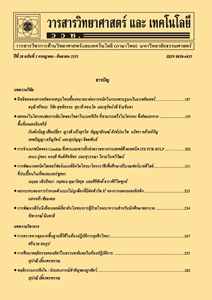Understanding of Lycopene and Factors Influencing Tomato Consumption in Songkhla Province
Main Article Content
Abstract
The objectives of this study were to study (1) social and economic conditions of consumers (2) tomato consumption behavior (3) knowledge and understanding about lycopene, and (4) factors influencing tomato consumption of consumers in Songkhla province. The structured interview was used to collect data from 400 samples. The descriptive analysis was done by simple statistics such as average, maximum, minimum, percentage, and factors influencing tomato consumption using multiple regression analysis. The results showed that tomato consumers in Songkhla province were female 53.0 %, male 47.0 %, the average age was 21 years, and the average income per month less than 5,000 Baht was 45.0 %. There were 55.5 % of consumers who did not consume tomato, and 45.5 % of those consumed tomato. They consumed fresh fruit, cooked and heat fruit, and processed tomato products as 78.1, 11.8, and 9.0 %, respectively. The average consumption of tomato 2-3 times a week was 33.2 %. Buying from the freshest markets was for 34.8 %. Moreover, consumers have a low level of knowledge and understanding about lycopene. The taste, trend, healthy and brand of the product were the factors that influence tomato consumption in Songkhla province, with the statistical significance at the level of 0.05.
Article Details
References
Pormmarin, K., 2017, Tomato, Planting Tomatoes at Our Home, Available Source: https://www.trueplookpanya.com/knowledge/content/57339/-blo-agragr-agr, January 15, 2020. (in Thai)
Chitakornkijsil, P., 1994, Production and export potential of tomatoes, pp. 360-371, Proceedings of the 32th Kasetsart University Annual Conference: Home Economics, Science, Engineering, Agro-Industry, Economics, Business Administration, Education, Humanities, Natural Resources and Environmental Economics, Kasetsart University, Bangkok. (in Thai)
Nochai, K. and Pongjanta, J., 2015, Effects of tomato variety and lycopene extraction methods on physicochemical properties of tomato powder, Thai J. KMUTT Res. Develop. 36(4): 409-421 (in Thai)
Inmaculada, N.G., Veronica, G.V., Javier, G.A., and Periago, M., 2011, Chemical profile, functional and antioxidant properties of tomato peel fiber, J. Food Res. Int. 44: 1528-1535. (in Thai)
Ketsakul, S., 2015, Tomato Production Technology, Available Source: http://www.doa.go.th/research/attachment.php?aid=2158, July 24, 2019. (in Thai)
Yotogyos, M. and Sawadisup, P., 2014, Sample Size Determinations in Research., Available Source: http://www.fsh.mi.th/k m/wp-content/uploads/2014/04/resch. pdf, July 24, 2019. (in Thai)
Kaewchot, P., 2010, Educational innova tion, Available Source: http://praphaphan.blogspot.com/2010/04/blog-post_06.html, 24 July 2019. (in Thai)
Phumchantuk, P., Palinthorn, F. and Choenkwan, S., 2015, Customers’ buying behaviors, needs and opinions on fresh tomato, Khon Kaen Agric. J. 48(Suppl. 1): 859-864. (in Thai)
Srisuk, W., 2010, How to Eat Tomatoes with High Lycopene, Available Source: https://pharmacy.mahidol.ac.th/th/knowledge/article/1/benefit-tomatoes-lycopene, July 2, 2020. (in Thai)
Ansongkhram, A., 2015, The Effect of Social Media on Working Citizens in Bangkok and the Surrounding Areas, Available Source: http://dspace.spu.ac.th/handle/123456789/5285, July 2, 2020. (in Thai)


